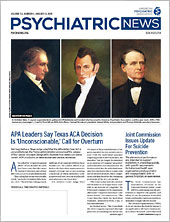As CEO and medical director of APA, one of my jobs is to focus on our future: Where should APA be directing its efforts in the next decade or two? What will psychiatric practice look like 10 years from now? How can we help our members adapt to the changing medical landscape?
If there’s one lesson that history has taught us, it is this: the future is shaped by the past, and we can’t prepare for tomorrow if we don’t understand where we came from and how we got there. This year, APA—the oldest medical specialty society in the U.S.—is marking an impressive milestone: its 175th anniversary. I am proud to represent APA on this important occasion, an opportunity to reflect on the past.
To that end,
Psychiatric News is launching a
series of articles in this issue on the history of APA and psychiatry in this country. Among the topics the series will address are the birth of APA, APA leaders and members who made major contributions to improving the care of people with mental illness, the development of treatment standards and the DSM, the introduction of antipsychotic drugs in the 1950s and the challenges of developing more effective pharmacologic treatments, legislation for which APA advocated that increased access to care, and APA’s efforts to increase the diversity of its membership and provide culturally sensitive care to minority and marginalized populations.
I first became involved with APA through the Burroughs Wellcome Fellowship (now the APA/APAF Leadership Fellowship), which included the privilege of sitting on the Board of Trustees for the 1988-89 term. It was a time of enormous change in psychiatry as insurers began the shift to managed care. For many psychiatrists, trained in an era when psychoanalysis was predominant, the changes were deeply concerning because they threatened the practice of a form of therapy that had been central to psychiatry for decades.
Coming of age as a physician during that period, I became acutely aware that medicine and psychiatry are always changing. In fact, change is the norm. At the same time, however, I also absorbed during that period the lesson that preparing for the future can never mean disowning our past. As we move today into an era of population-based and integrated care, psychiatry’s roots in psychoanalysis-psychodynamic psychotherapy remain strong, and psychotherapy will always be a valuable treatment tool.
We need now to especially remember psychiatry’s focus on the whole person, as neuroscience discoveries promise to give us new diagnostics, therapeutics, and prevention strategies.
One of the features of APA’s new headquarters of which I am most proud is our reborn Melvin Sabshin, M.D., Library and Archives, which helps to preserve our history and our heritage. With a collection that includes a page from the Gutenberg Bible, admission papers to the 18th century Bedlam Hospital in London, and hundreds of rare books and other artifacts contributed over the years by APA members, the library and archives is a rich trove for researchers and students of the history of psychiatry. Our APA Foundation has done an exemplary job of curating our treasures, and I warmly invite you to come to our new home and pay the library a visit.
One of the most remarkable artifacts preserved by the library is the “Utica Crib,” a bed enclosed within a wooden cage that locks from the outside. Utica State Hospital Superintendent Amariah Brigham, M.D., invented the crib as a way to calm patients who were deeply agitated or psychotic. Today we may look aghast at this relic from psychiatry’s history. But it is important to remember that at the time it was regarded as a great advance over the cruel practice of chaining patients to the floor, which was discontinued by many hospitals in the 1700s but then revived when the census at state hospitals began to grow in the 1800s.
Psychiatry has learned much since those days. Using the coming year to reflect on our past will help us shape our future as the physician specialists dedicated to healing the mind, brain, and body. Our history belongs to us, and we belong to our history. I hope you enjoy this series. ■

